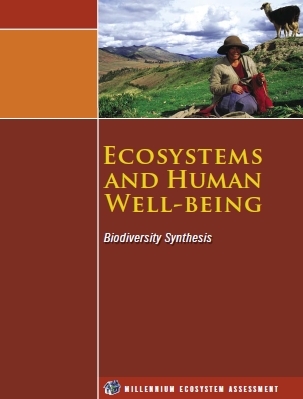Ecosystems and Human Well-being: Biodiversity Synthesis: Key Messages
This is part of the Millennium Ecosystem Assessmentt report Ecosystems and Human Well-Being: Biodiversity Synthesis
Extended Writing Team: MA Coordinating Lead Authors, Lead Authors, Contributing Authors, and Sub-global Assessment Coordinators
Review Editors: José Sarukhán and Anne Whyte (co-chairs) and MA Board of Review Editors
Key Messages
- Biodiversity benefits people through more than just its contribution to material welfare and livelihoods. Biodiversity contributes to security, resiliency, social relations, health, and freedom of choices and actions.
- Changes in biodiversity due to human activities were more rapid in the past 50 years than at any time in human history, and the drivers of change that cause biodiversity loss and lead to changes in ecosystem services are either steady, show no evidence of declining over time, or are increasing in intensity. Under the four plausible future scenarios developed by the MA, these rates of change in biodiversity are projected to continue, or to accelerate.
- Many people have benefited over the last century from the conversion of natural ecosystems to human-dominated ecosystems and from the exploitation of biodiversity. At the same time, however, these gains have been achieved at growing costs in the form of losses in biodiversity, degradation of many ecosystem services, and the exacerbation of poverty for other groups of people.
- The most important direct drivers of biodiversity loss and ecosystem service changes are habitat change (such as and use changes, physical modification of rivers or water withdrawal from rivers, loss of coral reefs, and damage to sea floors due to trawling), climate change, invasive alien species, overexploitation, and pollution.
- Improved valuation techniques and information on ecosystem services demonstrate that although many individuals benefit from biodiversity loss and ecosystem change, the costs borne by society of such changes are often higher. Even in instances where knowledge of benefits and costs is incomplete, the use of the precautionary approach may be warranted when the costs associated with ecosystem changes may be high or the changes irreversible.
- To achieve greater progress toward biodiversity conservation to improve human well-being and reduce poverty, it will be necessary to strengthen response options that are designed with the conservation and sustainable use of biodiversity and ecosystem services as the primary goal. These responses will not be sufficient, however, unless the indirect and direct drivers of change are addressed and the enabling conditions for implementation of the full suite of responses are established.
- Trade-offs between achieving the 2015 targets of the Millennium Development Goals and the 2010 target of reducing the rate of biodiversity loss are likely, although there are also many potential synergies between the various internationally agreed targets relating to biodiversity, environmental sustainability, and development. Coordinated implementation of these goals and targets would facilitate the consideration of trade-offs and synergies.
- An unprecedented effort would be needed to achieve by 2010 a significant reduction in the rate of biodiversity loss at all levels.
- Short-term goals and targets are not sufficient for the conservation and sustainable use of biodiversity and ecosystems. Given the characteristic response times for political, socioeconomic, and ecological systems, longer-term goals and targets (such as for 2050) are needed to guide policy and actions.
- Improved capability to predict the consequences of changes in drivers for biodiversity, ecosystem functioning, and ecosystem services, together with improved measures of biodiversity, would aid decision-making at all levels.
- Science can help ensure that decisions are made with the best available information, but ultimately the future of biodiversity will be determined by society.
Terms of Use
The copyright for material on this page is the property of the World Resources Institute. Click here for the Terms of Use (Ecosystems and Human Well-being: Biodiversity Synthesis: Key Messages).
Disclaimer: This chapter is taken wholly from, or contains information that was originally written for the Millennium Ecosystem Assessment as published by the World Resources Institute. The content has not been modified by the Encyclopedia of Earth.
|
|
